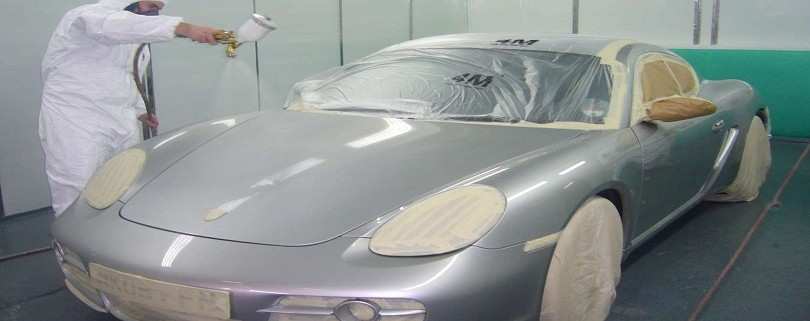Auto body dents come in all shapes and sizes, from a large crease to a shallow depression or just a little ding. One quality they all share is they distort the original shape of the sheet metal. The general definition of a “dent” is any place where the metal of the car’s body has been stretched. So, in order to repair the car body, one has to bring the dent back to its original shape by un-stretching the metal. Depending on the type of dent, one can “pop out the dent” or “pound out the dent.”
If you’re the DIY (Do It Yourself) type, then you’ll try to repair dents in your car’s body yourself. Before attempting this, compare the costs of hiring a professional with your confidence of doing the job properly yourself…and be honest about your auto body repair experience and ability. If you’re one of those people that starts a car “project” and then gets frustrated halfway through because it’s harder than you thought, (YOU know who you are!) then it is probably best only to risk a dent repair job yourself with an older, less expensive car. That way, the repair costs might already be more than the car’s actual value. Even then, you may only be able to repair fender dents, as they can be removed without anything from the car’s interior getting in the way (IE inner door panels).
There are two main types of car dent repairs: paint restoration repair and dent repair without paint. The first type of dent repair is for minor dents and “dings,” and paint restoration dent repair is for when serious damage was inflicted on the car body part(s). Many car owners, especially in this economy, are looking for ways to get around paying to take their car to an auto repair shop. With this in mind, I’ll cover both DIY small dent removal and large dent repair. I’ll put a disclaimer right up front that the following methods with not work for every dent, every time. Yet, there is no harm in trying them to “save a buck.”
Small Dents & Do It Yourself DIY Fender Dent Repair
SOFT HAMMER DENT REMOVAL:
Most cars today feature a car body so thin and flexible that dents can be created accidentally by simply leaning on your car! Most very small dents can be easily repaired with a soft hammer. Always aim for the center of the dent, to avoid making new marks on the outer circumference of it, and “pound out” the depression.
NOTE: you may have to view the dent from the underside of the car. With a fender dent, this can only be done by raising the vehicle and removing the wheel under the dent. Then, while hammering with one hand, you can feel the outside of the fender with your other. This allows you to check that the dent is evenly pushed out. If you *still* can’t remove the dent, jump ahead to the “large dent removal” section of this article, as you will have to remove the fender from the car.
TORCH, LIGHTER & HAIR DRYER DENT REMOVAL:
Metacafe.com/watch/963248/remove_car_dent_with_a_lighter/
You can heat the convex (dented) portion of a car dent with a torch, lighter or hair dryer, until it glows a dull red. Then stop heating it and let the dented surface cool. As the metal cools, the dent will shrink back, and hopefully pop out, leaving the surface very close to the original.
SUCTION CUP DENT REMOVAL:
If you are not able to “pound out” your “small dent” easily, you may have a medium dent in your car. In that case, you can attach a large suction cup with a handle to the dented car part…and “pull out” the dent. How does this work?
As you squeeze the cup against the car body’s dented surface, you are actually squeezing the air out from underneath it. The resulting “vacuum” you create causes the suction cup to stick onto the surface. Start by placing the suction cup along the edge of the dent, pulling it out, and slowly working your way inward. If you’re still having trouble, you should try tapping the dent with a soft hammer, from the inside, while you pull out the dent from the outside.
DRY ICE DENT REMOVAL:
A How-To Video of DRY ICE DENT REMOVAL:
http://metacafe.com/watch/yt-ab5PdrAIKeo/how_to_cure_car_dent_with_dry_ice/
Dry ice may be used to repair a small car dent and is sold by many grocery stores. (Always remember to use gloves when handling dry ice!) Simply place the dry ice in the center of the dent, wait for it to attach firmly to the car body, and gently pull out the dent. You may have to repeat this procedure several times for the dent to be totally removed.
Large Dents & Do It Yourself DIY Car Dent Repair
OK…the Intro To DIY Dent Removal 101 class ends HERE. The following techniques are for large dents, requiring more car repair experience and skill. Start by removing all bolts from the fender, and taking it off the car body. If you can’t remove the fender, there is at least one hidden bolt left intact…find it and remove it. NOTE: Never force the fender of a car. (*Some* mechanics also recommend you drill a hole in the center of the dent, using a 1/8 inch drill bit. This is entirely up to YOU. If you are using a dent repair kit, you will most likely find a plastic adapter and glue gun included, and these would be used for that task.) Once the fender is lifted off, use a heavier hammer to “pound out” the dents from the fender’s underside. Always start from the CENTER of the dent and use short, small taps on the dent, not long, hard ones. As you pound out the dent, hold a hammer dolly against the outside of the fender to prevent making new protrusions around the dent. If the fender supports are bent, be sure to straighten them back out with vice-grip pliers. After you’ve successfully fixed the dent, simply re-attach all the bolts and put the fender back on the car.
Body hammers and hammer dollies come in many shapes, sizes and weights. First, examine the dent closely with a ruler for depth and length. Then, always choose the best-shaped and smallest size hammer that will do the job, and the dolly that has the closest curvature to the dented panel. If you don’t have body tools, you can try to use a ball peen hammer and solid scrap metal piece as your dolly. This will take a lot of taps, but won’t do as much damage to your car body panel. Since all dents are unique, so is each dent repair, and you truly have to use your own best judgment to get the metal straightened. Start by placing the dolly against the top side of the dent and, swinging the hammer from the underside of the dent, begin tapping with MANY short, small taps.
*
The fender pictured above has a typical dent in the side: oval-shaped, 3 inches long and 2 inches wide. In that case, they used a hammer with a large, flat round top, to be sure the overall force of the blows would be evenly transmitted over an area of a couple square inches. This helped “pound out the dent” without creating unsightly, little pin-sized mounds.
*
The head of the hammer should strike the sheet metal flat against its surface, as, at the same time,
you hold the dolly directly over where you are striking.
Note that, after every few taps, you must lift the dolly and examine the dent to be sure the taps are reducing the depth of the dent AND not resulting in little convex dents. If the taps are leaving little mounds on the surface, you must start using a hammer with a larger head. If the dent hasn’t moved at all, put the dolly down and hit the inside of the dent harder.
*
After the dent popped out, it left a slightly raised section, which is easily seen under the straight edge.
If you “pop out” the dent, but end up with one spot that stands up too high, don’t worry. This is common, and there are two ways to fix this “reverse-dent.” This time, put the dolly underneath the fender and gently tap the convex (raised) area with the smaller head of the hammer. Repetitive, small hammer hits should level the surface completely.
How To Tell If The Repair Conforms
To The Original Car Body Surface?
*
Using the body file, you can find the high spots that need additional attention,
and very lightly tap them down until the surface returns to its original shape again.
You can now file the once dented area, scraping off the etching primer coating. As you file the surface, take note of which areas are still a little low and which are now a bit too high. Go back and re-do one of the above methods until the dent is removed enough to meet your standards. Then, use a medium grit disk mounted on a drill to grind the paint down to the bare metal for at least one inch around the dent. Next, fill the area with a high-quality body filler. Allow that to dry completely, then sand the area with a block of wood wrapped in sandpaper. Prime the area with 6 coats of automotive spray primer. Be sure to allow each coat of primer to dry completely before applying the next one over it. Sand the primer using a 600-grit wet and dry sandpaper to remove scratches. Touch up the area with matching automotive paint. When applying automotive paint, do so using a spray gun and in brisk, fluid motion. If the newly painted area is not smooth, re-sand and re-paint it until it is.
How good you need your dent repair to be is really up to each individual. You can keep “working the dent” until your file shows the metal surface is perfect, or you can leave little “low spots” to be filled later with body filler. NOTE: Overworking the metal can leave it brittle, and it might begin to crack instead of bend. Sometimes…Less IS more! *smile* Generally, if you are considered (by yourself or others) to be a “Perfectionist,” then it’s probably best to have your car professionally repaired to it’s original, perfect self. Otherwise, you might find yourself endlessly obsessing and “working the dent” until it cracks. If your standards are more flexible, you’re on a tight budget and are handy with a hammer, then try our dent repair methods and let us know how it goes…GOOD LUCK!





